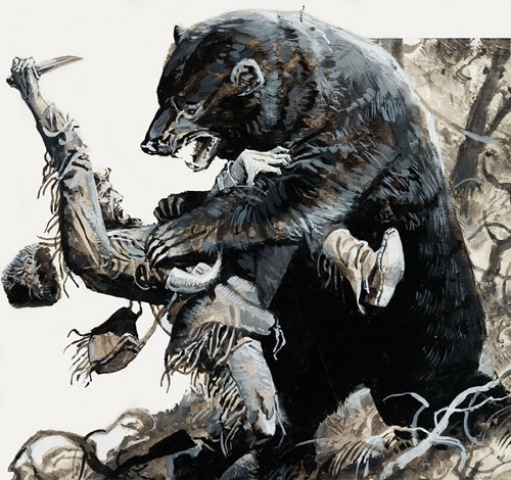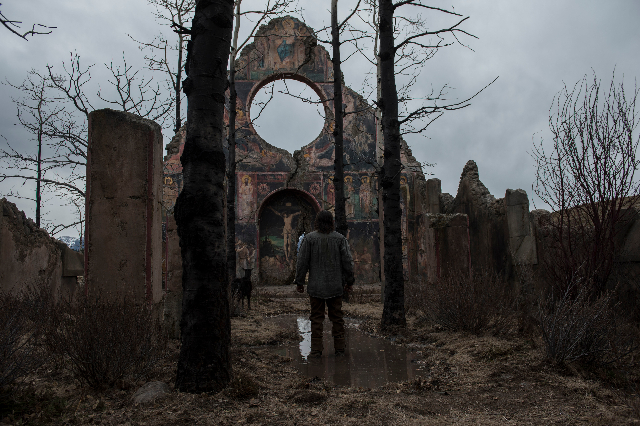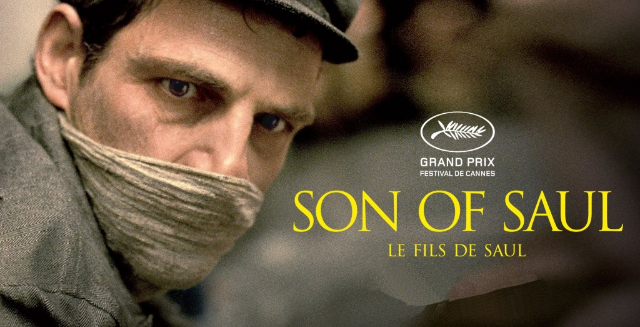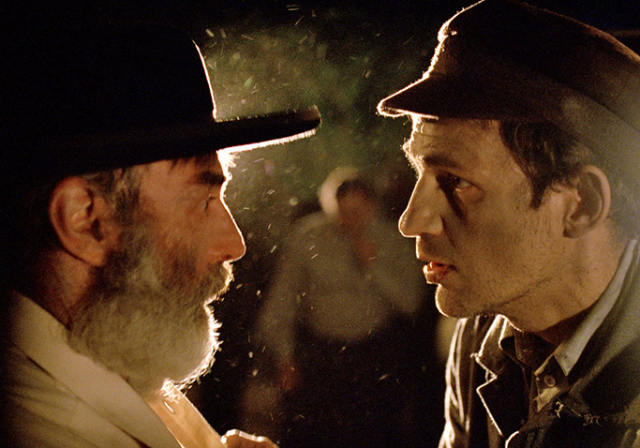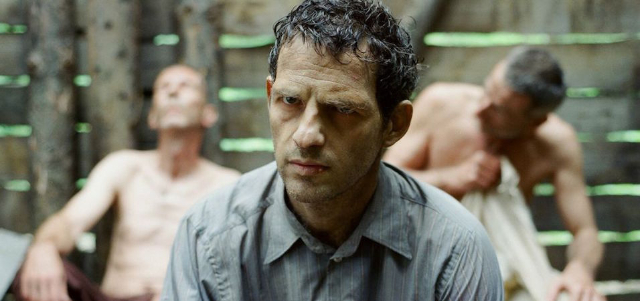Overview of Two Oscar Winners
Revenant and Son of Saul
By: Nancy Kempf - Mar 03, 2016
|
|
Sometimes even to live is an act of courage.
~~Seneca
You don't ask people with knives in their stomachs what would make them happy; happiness is no longer the point. It's all about survival; it's all about whether you pull the knife out and bleed to death or keep it in...
~~Nick Hornby, “How to Be Good”
Two of the most highly acclaimed films of this awards season have been Alejandro González Iñárritu's “The Revenant” and László Nemes’s “Son of Saul.” Oscars went to Iñárritu for Directing, Leonardo DiCaprio for Best Actor and Emmanuel Lubezki for Cinematography. Nemes’s “Son of Saul” won the Best Foreign Language Film Oscar. Both films center on a protagonist in unimaginable torment. One survives through an obsession with vengeance, the other through an obsession with atonement.
THE REVENANT
The Hugh Glass mauling incident is a perfect choice for a filmmaker given the ambiguity of the historical record, which leaves Iñárritu free to make of his narrative what he will. Hugh Glass was indeed a seasoned fur trapper who explored the watershed of the Upper Missouri River. Like a Jay Gatsby frontiersman, little is known about him. One rumor has it he was captured by privateers and forced to live as a pirate; another that he was captured by Pawnee Indians and lived among them for years, even taking a Pawnee wife. It is known that he accompanied several Pawnee delegates who had been invited to meet with U.S. authorities in 1821.
In 1822, one General William Ashley placed an advertisement in the Missouri Republican for 100 "enterprising young men...to ascend the river Missouri to its source, there to be employed for one, two, or three years" for a fur-trading venture that would become the Rocky Mountain Fur Company. In June 1823, believing they were being heralded by friendly Pawnee, the party went ashore only to be attacked by Arikara/Ree warriors. Survivors fled back to the long boats. Ashley’s associate, Andrew Henry, believed it prudent to abandon the river route, so, parting company with Ashley, he led fourteen of the men overland toward Fort Kiowa on the Missouri.
Glass kept to himself along the way, and in August, near the forks of the Grand River, was scouting for game when he surprised a grizzly with two cubs. The bear charged, Glass got off a shot, and the bear mauled him into unconsciousness. From there the story becomes conveniently murky. In one version, Glass’s trapping partners, John Fitzgerald and Jim Bridger, manage to kill the bear; in others, Glass kills the bear before they get to him. However the incident transpired, Glass appeared to his partners fatally injured. When Henry arrived, he, too, was convinced Glass could not survive, and he assigned Fitzgerald and Bridger to stay with Glass. In some accounts, they waited for as long as five days for Glass to die before abandoning him.
Iñárritu follows this historical record quite faithfully, only streamlining time and fusing Ashley and Henry into a single character for narrative economy. Where he strays is to conjecture a child for Glass by his Pawnee wife. His son Hawk’s murder at the hands of Fitzgerald, then, becomes the motive for vengeance, a far nobler motive than his own abandonment.
Sitting in our comfortably air conditioned theater, it might seem more ethical for the men to carry Glass along and try to mend him back to health -- and they do patch him up as best they can. Yet, throughout the film, Fitzgerald, brilliantly embodied by Tom Hardy, makes the more pragmatic argument. You might not like the racist Fitzgerald, but he is not a coward or a fool. As the men attempt to move Glass on a makeshift litter, Anderson says to Fitzgerald, “They’re torturin’ the bastard,” to which Fitzgerald’s realistic rejoinder is: “And riskin’ gettin’ the rest of us killed in the process. Proper thing would be to end it for him quick.” When they finally stop, he tells Henry, “You ain’t doin’ him or us no favors, Captain, lettin’ him suffer that way.” And much as we might like to take a romantic view and condemn this line of reasoning, he’s right.
About midway through “The Revenant” a scene occurs that to me seems central to the film. Fitzgerald and young Bridger are camped by a fire, when Fitzgerald starts to wax nostalgic and tell a story about his father, “who never believed in anything 'cept what he could use or shoot and eat. […] Then, starving and delirious on the Texas plain, he found God. And it turns out… God's a squirrel. And a big, meaty one. And he shot and ate that son of a bitch.” This story is not only a metaphor for Fitzgerald’s point of view, but the metaphor for the entire film. Survival comes at the expense of something or someone else. Exploitation is the law of nature.
“The Revenant” hinges on this existential reality. The bear that mauls Glass protects her cubs and the wolves that maul the buffalo calf feed their pack. Likewise, we survive at someone's or something's expense. We exploit resources – buffalo hides, forests, fossil fuels, human labor. (Who and what was involved in getting the precious metals out of the ground and into this MacBook I'm so blithely tapping away on?) That's what “The Revenant” is about. Some people grumbled about its being long and to a great extent, it is long in order to make us uncomfortable – and it doesn't make us nearly uncomfortable enough. It's too visually and aurally gorgeous for that.
Much has been written about Iñárritu’s desire to eschew CGI and use natural landscapes and available light, especially the dying light of the gloaming. This was one way to capture the lyricism of the novel upon which the film is based. In “The Revenant: A Novel of Revenge,” Michael Punke writes of the gloaming, “It was an interlude that he held as sacred as Sabbath, the brief segue between the light of day and the dark of night. [….] It was a moment for reflection in a space so vast it could only be divine. And if Glass believed in a god, surely it resided in this great western expanse. Not a physical presence, but an idea, something beyond man’s ability to comprehend, something larger.”
Some have referred to “The Revenant” as a Western, but Iñárritu rejects the categorization. “I wouldn’t say that Westerns were a big influence on “The Revenant” at all, really. I was looking more toward things like “Dersu Uzala” by Kurosawa, Tarkovsky’s “Andrei Rublev” – which is maybe my favorite film ever – Herzog’s “Aguirre, the Wrath of God” and “Fitzcarraldo,” even “Apocalypse Now.” These are movies that…are informed by the crazy…theatrical show that is the human condition. The beauty and harshness of nature impacts your state of mind in these movies. There’s a very intimate point of view from one single character in each. That’s the challenge. Anyone can film a beautiful landscape. Unless you have an emotionally grounded story…, it’s all just…sorcery.” (David Fear. “Into the Woods.” Interview with Alejandro Iñárritu. Film Comment. January/February 2016. Web. 26 Feb. 2016.)
Iñárritu infuses his film with this numinous quality through a series of dream sequences that punctuate the narrative. They reveal not only details of Glass’s past, but also glimpses into the mystery of humanity as it moves through the natural world. One sequence in particular – in the courtyard of a church ruins – is simultaneously an homage to Andrei Tarkovsky’s “Andrei Rublev” and to Béla Tarr’s “Satantango” and “The Turin Horse.”
In “Apocalypse Withheld: On Slowness & the Long Take in Béla Tarr’s ‘Satantango,’ ” (May 15, 2014), Janice Lee notes that “Cinephiles often compare Tarr to Andrei Tarkovsky. In response to this correlation, Tarr says: ‘The main difference is Tarkovsky’s religious and [I am] not… [h]e always had hope; he believed in God. He’s much more innocent than… me… Rain in his films purifies people. In mine, it just makes mud.’ ”
In Iñárritu’s telling, Glass exacts his revenge, but the record indicates that Glass found Fort Henry abandoned. Apparently a note indicated that Andrew Henry had relocated the company to a camp at the mouth of the Bighorn River. There, Glass found Bridger but is said to have forgiven him as an impressionable youth. Turns out, he spared Fitzgerald, too, perhaps because Fitzgerald had joined the United States Army, and the penalty for killing a soldier was harsh. When we mythologize true stories, we can hang meaning on them, but the true story itself too often gives the lie to the legend.
SON OF SAUL
“Son of Saul” opens not only in extreme long shot and not merely in soft focus but entirely out of focus. A long focus-through ensues before we finally make out the contours of our protagonist. The opening establishes two motifs: the verdancy of nature juxtaposed with its indifference and the isolation of the individual in suffering. The solitary man in the midst of the controlled chaos that is Auschwitz-Birkenauis is Saul Ausländer, a Hungarian Jew and a member of the Sonderkommandos.
In his debut feature film, Hungarian director László Nemes breaks new ground. The telling of the Holocaust, a seemingly inexhaustible source of narrative fodder, has focused on prisoners’ sufferings in the camps or on exposing and dealing out punishment to those who engineered the death camps and allowed their perpetration. The gas chambers and smoke stacks are there, but the narrative arc typically follows characters who have escaped the ovens rather than dwell on the apparatus of death for the entire course of the film.
Nemes takes us into the deepest reaches of the Nazi hell – the Sonderkommandos’ world, and though the Sonderkommandos are groups of camp prisoners, each individual is under a death sentence so that his struggle for survival isolates him from the men at his shoulders.
Like no director I can think of before him, Nemes uses cinematography and sound and a single point of view to impress upon us the relentlessness of living cheek by jowl with the industrial scale of the Nazi killing. Moving in and out of soft focus gives a sense of the blur of exhaustion overcome only by the adrenaline of fear, the frenzied confusion and clamor of panic, the acrid burning and blistering swelter from coal dust and human ash. The sound is often unintelligible noise – the blast and blare of machinery, a cacophony of screams and struggle, the desperate Babel of incoherent tongues – a living hell made all the worse by the mounting hubris of the Nazi project by late 1944. Transports come in faster than the bodies they carry can be disposed of, making an already incomprehensibly harrowing environment beyond all tolerance or understanding.
The German sociologist Wolfgang Sofsky, in his 1992 study “The Order of Terror: The Concentration Camp” writes, “The agonies suffered by members of the Sonderkommandos defy description. Attempts at interpretation must necessarily remain superficial. Nonetheless, some comments on this most extreme form of forced collaboration are in order. These individuals worked in a situation of the constant threat of death and paralyzing violence. The SS let them live in order to work. Whoever refused was put to death. On July 21, 1944, when four hundred Jews from Corfu who had spent three weeks in the quarantine camp refused any involvement with the Sonderkommando, they were gassed.
Whoever wished to live another hour had to work. The only way out was suicide – martyrdom. It is known that some did commit suicide while being admitted to the Sonderkommando or immediately thereafter. In addition, there was no certainty whatsoever about how long a respite one might have. No one could predict when the SS would liquidate the Sonderkommando. Yet one often clings to the slimmest of hopes so long as the end is not imminent, even if virtually all facts speak against it. The sheer will to survive triggers rigorous defense mechanisms that brush aside even the greatest dangers. The death of the other person is not your own. Even in a situation of certain death, people frequently do not react with rebellion, but with apathy” (270-271).
It is against this apathy – and his own complicity in death – that Saul’s consciousness and conscience seize upon one boy’s body – to spare him the ovens, to find a rabbi to say Kaddish, to give him a reverential burial. In the face of Saul’s plight, his insistence on Kaddish is profound, for in the act of saying Kaddish one affirms belief in the goodness and sovereignty of God, even – or especially – in the face of death. Central to the act of saying Kaddish is remembrance, the obligation to never forget, and above all, it is a prayer that speaks not to the past but to the future, a time of redemption.
Y'hei sh'lama raba min sh'maya,
v'chayim aleinu v'al kol Yisrael.
V'imru: Amen.
He who creates peace in His celestial heights,
may He create peace for us and for all Israel;
and say, Amen.
In his director’s notes, Nemes explains that “Our aim was to take an entirely different path from the usual approach of historical dramas, their gigantic scope and multi-point of view narration. This film does not tell the story of the Holocaust, but the simple story of one man caught in a dreadful situation, in a limited framework of space and time. Two days in the life of a man forced to lose his humanity and who finds moral survival in the salvaging of a dead body.”
Géza Röhrig, who plays Saul, was born in Hungary. His father died when he was four, and he spent several years in an orphanage before being adopted. He was expelled from high school in Paris for anti-communist activity. He studied Hungarian and Polish as a university student and holds a degree in filmmaking from the Academy of Drama and Film in Budapest. After a visit to Auschwitz, he moved to Jerusalem and then to Manhattan to study at the Jewish Theology Seminary, became an Hasidic Jew, has been teaching kindergarten since 2000 and has published many collections of poetry, including “Book of Incineration” (1995) and “Captivity” (1997). I cite this vitae at length to suggest that few actors could be as uniquely qualified to embody the cursed soul of Saul.
Speaking at the film’s press conference at Cannes, Röhrig bristled at a reporter’s suggestion that the Sonderkommandos were “half-victims, half-hangmen.” (Catherine Shoard. “ ‘Son of Saul’ star: ‘God was holding the hand of every Jew in the gas chamber.’ ” The Guardian. January/February 2016.)
“ ‘[T]he Sonderkommando were not just equally victimised but more victimised. They lived in the epicentre of hell. I think they deserve utmost respect. Some of them tried to make their way into the gas chambers instead.’ [T]he Sonderkommando have long been the victims of such ignorance. ‘Partly because everything about them was hearsay. The rules of the Nazis meant they couldn’t meet with the rest of the inmates, so they were somewhat mysterious. And the victims had so much anger and frustration, they projected it on to them.’ ”
“With movies like ‘Schindler’s List,’ you have an evil guy and you have a good guy,” Röhrig told The Guardian. “There’s no such thing. We are all evil and good inside. [….] [I]t wasn’t God who rounded up the Jews and the Gypsies and the Soviet PoWs and the gays and the perfectly German mental patients and the perfectly German midgets and slaughtered them,” he continued. “We did it. The human family did it.”
Röhrig wisely noted, “I think it’s fair to say that we haven’t learned anything from Auschwitz. The cruelty exhibited there exists today...”
Reposted by Nancy Kempf from My Own Private Cinema.


